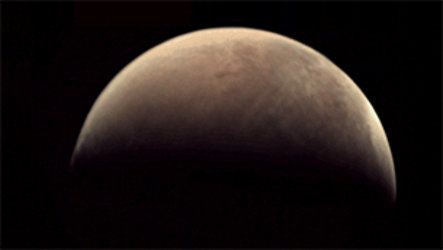Flying over Becquerel
This latest release from the camera on ESA’s Mars Express is a simulated flight over the Becquerel crater, showing large-scale deposits of sedimentary material.
The 167 km-diameter Becquerel crater is located in the Arabia Terra region, straddling the transition between the rough southern highlands and the smoother northern lowlands on Mars. Like many other craters in the region, its floor plays host to a fine display of layered sedimentary deposits that have been studied in detail using images and spectral data from NASA’s Mars Global Surveyor and Mars Reconnaissance Observatory missions. This new movie from the high-resolution stereo camera on Mars Express provides an excellent overview of the wider context.
The light-toned deposits are known to be composed of sulphate-bearing rocks. On Earth, sulphates such as gypsum result from the evaporation of water, and the common occurrence of these layered sedimentary deposits in Arabia Terra points towards a key role having been played by water in laying down them down.
For Becquerel crater, the current thinking is that an initial impact crater was later filled by wind-blown sediments and/or volcanic ash, mixed with upwelling ground water in the low-lying crater floor. The sequence of layers could be explained by seasonal variations or episodic oscillations in the planet’s rotational axis.
Subsequent erosion by wind can leave a mound of sediments as seen in the movie. Evidence for this can be seen in the dark material surrounding the light-toned sedimentary deposits: this is thought to be wind-blown dust from a source somewhere to the north of Becquerel.
In more detail, however, these theories are being hotly debated in the scientific community and ground-truth data are needed in order to resolve the controversy. Fortunately, Gale crater is also home to a large mound of sedimentary deposits known as Mount Sharp, and NASA’s Curiosity rover is currently carrying out detailed surface geology studies there.
This movie is the first product from Mars Express to be released under a Creative Commons licence, by joint agreement between ESA, the DLR German Aerospace Center and Freie Universität Berlin. As with Rosetta’s navigation camera images, all future and previously released Mars Express High Resolution Stereo Camera images will be covered under the same licence, as described in this accompanying blog post.















 Germany
Germany
 Austria
Austria
 Belgium
Belgium
 Denmark
Denmark
 Spain
Spain
 Estonia
Estonia
 Finland
Finland
 France
France
 Greece
Greece
 Hungary
Hungary
 Ireland
Ireland
 Italy
Italy
 Luxembourg
Luxembourg
 Norway
Norway
 The Netherlands
The Netherlands
 Poland
Poland
 Portugal
Portugal
 Czechia
Czechia
 Romania
Romania
 United Kingdom
United Kingdom
 Slovenia
Slovenia
 Sweden
Sweden
 Switzerland
Switzerland

































